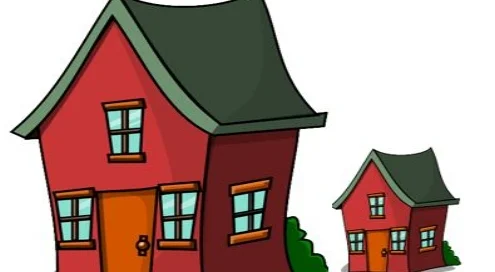1935
Eugene passes its first zoning code. It allows for one home per lot in most neighborhoods, with no allowance for accessory dwelling units.
1948
A major update of the zoning code is passed, which includes a definition for guest houses/servants quarters—structures which in the future would be ideal to convert into ADUs, but they are not permitted to be rented. The separate definition has disappeared by 1971, but for the next 40 years, what we would now call “Accessory Dwelling Units” are considered either duplexes or an accessory use for a single family home.
1985
A revision to the residential zoning is completed, and the first specific language surrounding what we now consider ADUs is included. They are called “Single Family Accessory Units” and are permitted in the R-1 and (defunct) RA zones. It only permits detached secondary dwellings, requires owner-occupancy, sets a size limit of 600 square feet, but does not have a lot size minimum.
Eugene does a complete update of its zoning code. The maximum size of an ADU is expanded to 800 square feet, but owner-occupancy requirements are strengthened through the additional requirement that prior to the issuance of an occupancy permit, “a notice with Lane County Deeds and Records that the secondary dwelling or primary dwelling shall remain owner-occupied.”
Several Council meetings as this massive project was undertaken discuss what is now referred to as “Secondary Dwelling Units.” Councilors Taylor and Bettman moved to prohibit detached secondary dwelling units all together. Councilor Taylor attempted to introduce a change that would have had the effect of eliminating detached secondary dwelling units, which failed for lack of a second.
2000-2001
As part of the follow-up process from the major code revisions, Council makes some additional adjustments to standards for Secondary Dwelling Units, including adding a minimum lot size for ADUs of 4500 square feet for an attached ADU and 6000 square feet for a detached ADU.
2002
The Single Family Code Revision Process starts. This was initiated as an “efficiency” project, in a attempt to develop ways to use our land without the UGB more effectively, but primarily added to barriers and restrictions to ADUs and other compact housing types. The initial proposal was recommended to Council by the Planning Commission in October of 2013. This initial proposal included reducing height limits, adding sloped setbacks to ADUs, and adding an adjustment review process. Most notably, it added a level of absurdity to the owner-occupancy requirement—in addition to a deed restriction, homeowners wishing to build an ADU are now required to proactively verify their occupancy with the City every two years, and if a medical or other similar situation requires them to live somewhere else for more than six months, they must provide the city with documentation from a medical provider (i.e. the City is asking for a doctor’s note.)
Between the time Planning Commission reviewed the proposal in October of 2013 and its eventual passage on July 28th, 2014 additional modifications were made at the behest of a group of neighborhood activist, including increasing the lot size minimums for both attached and detached ADUs (removing the ability of over 4000 property owners to build ADUs.) In addition, special restrictions were written for three neighborhoods in Eugene that placed even more requirements on ADUs, such as a maximum bedroom limit in relation to the number of bedrooms in the main house and an even greater lot size minimum.
In the 30 years since ADUs were originally introduced in Eugene’s code, the special standards and restrictions applied to them went from approximately a third of a page of text to about 10 pages of unique restrictions and requirements.
2013-14
The Oregon State Legislature passes SB 1051 as one step to address the increasing housing crisis in Oregon. One of the four main provisions stated that cities like Eugene shall allow “the development of at least one accessory dwelling unit for each detached single-family dwelling” While most cities in Oregon go on to implement necessary changes to allow every home owner who wants them the ability to build an ADU of some form or another, Eugene does not.
July 2017
Along with a dozen other organizations, WE CAN submits a letter to City Council, asking for the prompt implementation of changes to Eugene’s zoning code to make cottages easier to build, including both ADUs and Cottage Clusters. A petition with a similar request garners over 250 signatures from Eugene citizens.
January 3rd, 2018
The Eugene City Council initiates a two-phase process to address ADUs in Eugene. Phase one adds “Secondary Dwelling Units” as a permitted housing type in zones that previously allowed detached single-family homes but didn’t explicitly allow secondary dwellings. The City decides to wait to address substantive changes until “Phase II.”
January 22nd, 2018
The recommendation goes to the Eugene Planning Commission. The Planning Commission receives many comments requesting that ADUs be made easier in Eugene. After minor modifications, the Planning Commission recommends that City Council pass the proposal to permit ADUs in the recommended zones, and that they move expediently onto Phase II of the project.
March 26th, 2018
The Eugene City Council receives public comment regarding the proposal, with the majority requesting that ADUs be made easier in Eugene. Council declines to make substantive changes to the proposal, with two exceptions. First, they modify the proposal to change the terminology from Secondary Dwelling Units to Accessory Dwelling Units to match the state’s language.
On May 23rd, Councilor Emily Semple introduces a motion including code language submitted in to the record by Paul Conte and Ted Coopman that explicitly prohibits ADUs in the Jefferson Westside and Chambers Special Area Zones. Council votes unanimously to include this prohibition.
After advice from the city’s lawyers on June 11th that indicates that such a prohibition is unlikely to hold up on appeal, Council modifies the language to say that buildings that function like ADUs in those areas can not be called ADUs. This all passes unanimously.
May and June 2018
The Homebuilders Association appeals to the Land Use Board of Appeals Eugene’s handling of compliance with SB 1051, arguing that Eugene has failed to follow state law. They are joined in their appeal by 1000 Friends of Oregon, AARP Oregon, The Eugene Chamber of Commerce, Housing Land Advocates, WE CAN, and two individual residents.
July 2018
On November 29th, the State Land Use Board of Appeals (LUBA) sent Accessory Dwelling Unit regulations back to the City of Eugene for further evaluation to determine if our regulations on ADUs are "reasonable" and "related to siting and design." in the Home Builders Association v City of Eugene and the Kamps-Hughes v City of Eugene decisions.

